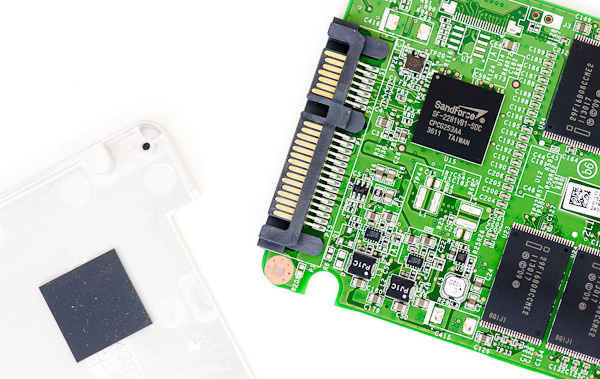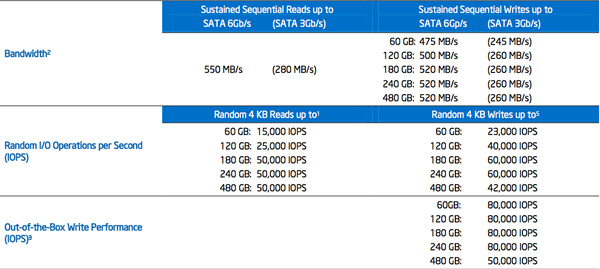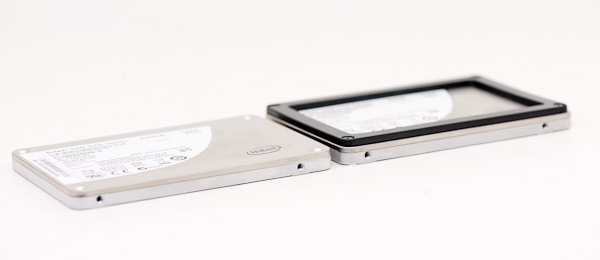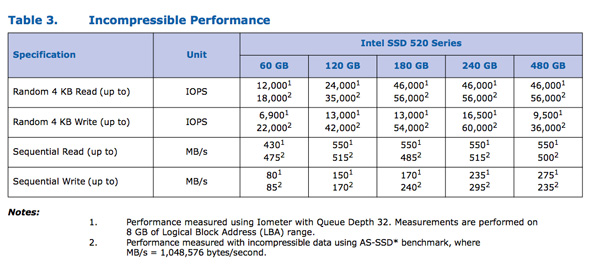Intel SSD 520 Review: Cherryville Brings Reliability to SandForce
by Anand Lal Shimpi on February 6, 2012 11:00 AM ESTThe Intel SSD 520
Intel sent us a 240GB and 60GB SSD 520 for review, but the performance specs of the entire family are in the table below:
The Intel SSD 520 is available in both 9.5mm and 7mm versions, with the exception of the 480GB flavor that only comes in a 9.5mm chassis. The 520's uses Intel's standard 7mm chassis with a 2.5mm removable plastic adapter that we've seen since the X25-M G2. The plastic adapter allows the drive to fit in bays designed for 9.5mm drives. Note that Intel doesn't ship shorter screws with the 9.5mm drives so you can't just remove the plastic adapter and re-use the existing screws if your system only accepts a 7mm drive.
Inside the drive we see the oh-so-familiar SandForce SF-2281 controller and Intel 25nm MLC NAND. The controller revision appears unchanged from other SF drives we've seen over the past year. The PCB design is unique to the 520, making it and the custom Intel firmware the two noticeable differences between this and other SF-2281 drives.

Intel uses the metal drive chassis as a heatsink for the SF-2281 controller
The SF-2281 Controller
I've explained how the SF-2281 works in the past, but for those of you who aren't familiar with the technology I'll provide a quick recap. Tracking the location of data written to an SSD ends up being one of the most difficult things a controller has to do. There are a number of requirements that must be met. Data can't be written to the same NAND cells too frequently and it should be spread out across as many different NAND die as possible (to improve performance). For large sequential transfers, meeting these (and other) requirements isn't difficult. Problems arise when you've got short bursts of random data that can't be combined. The end result is leaving the drive in a highly fragmented state that is suboptimal for achieving good performance.
You can get around the issue of tracking tons of data by simply not allowing small groups of data to be written. Track data at the block level, always requiring large writes, and your controller has a much easier job. Unfortunately block mapping results in very poor small file random write performance as we've seen in earlier architectures so this approach isn't very useful for anything outside of CF/SD cards for use in cameras.
A controller can rise to the challenge by having large amounts of cache (on-die and externally) to help deal with managing huge NAND mapping tables. Combine tons of fast storage with a fast controller and intelligent firmware and you've got a good chance of building a high performance SSD.

SandForce's solution leverages the work smart not hard philosophy. SF controllers reduce the amount of data that has to be tracked on NAND by compressing any data the host asks to write to the drive. From the host's perspective, the drive wrote everything that was asked of it, but from the SSD's perspective only the simplest representation of the data is stored on the drive. Running real-time compression/de-duplication algorithms in hardware isn't very difficult and the result is great performance for a majority of workloads (you can't really write faster than a controller that doesn't actually write all of the data to NAND). The only limit to SandForce's technology is that any data that can't be compressed (highly random bits or data that's already compressed) isn't written nearly as quickly.
Intel does a great job of spelling out the differences in performance depending on the type of data you write to the SSD 520, but it's something that customers of previous Intel SSDs haven't had to worry about. Most client users stand to benefit from SandForce's technology and it's actually very exciting for a lot of enterprise workloads as well, but you do need to pay attention to what you're going to be doing with the drive before deciding on it.
The Intel SSD Toolbox
The Intel SSD 520 works flawlessly with the latest version of Intel's SSD Toolbox. The toolbox allows you to secure erase the drive from within Windows, and it also allows you to perform firmware updates and pull SMART info from the drive. Unlike other SandForce toolboxes, Intel's software works fine with Intel's RST drivers installed.

The Test
| CPU | Intel Core i7 2600K running at 3.4GHz (Turbo & EIST Disabled) - for AT SB 2011, AS SSD & ATTO |
| Motherboard: | Intel DH67BL Motherboard |
| Chipset: | Intel H67 |
| Chipset Drivers: | Intel 9.1.1.1015 + Intel RST 10.2 |
| Memory: | Corsair Vengeance DDR3-1333 2 x 2GB (7-7-7-20) |
| Video Card: | eVGA GeForce GTX 285 |
| Video Drivers: | NVIDIA ForceWare 190.38 64-bit |
| Desktop Resolution: | 1920 x 1200 |
| OS: | Windows 7 x64 |























138 Comments
View All Comments
eman17j - Wednesday, February 8, 2012 - link
Are you trying to say that Amd's cpus are unreliable? I have one and I have no problems at all with it. I dont have crashes or freezes.bji - Wednesday, February 8, 2012 - link
He's a beginner. He doesn't know what he's talking about.eman17j - Wednesday, February 8, 2012 - link
Wrong because the business buys the drive at an higher price then raises the price on their product or service and passes the cost of the drive to the consumer so the consumer ends up paying for the price premium anywaysgamoniac - Monday, February 6, 2012 - link
Is playing game part of Brian's job description?Brian Klug - Monday, February 6, 2012 - link
Heheh, I guess you could say that for once, yes, playing BF3 was part of the job! :)-Brian
Oberst - Monday, February 6, 2012 - link
Seems like there is the first customer with the bsod bug in the intel forum. It seems like the reliability is no better than at all the other SF drives and it's just a matter of (bad) luck.http://communities.intel.com/message/149389#149389
Makaveli - Monday, February 6, 2012 - link
That tool installed his brand new Intel 520 drive in IDE mode?NitroWare - Wednesday, February 8, 2012 - link
You would be surprised how many laptop owners (and even desktop owners) are unaware that they should use AHCI mode. I can guarantee that there are millions of boards out there with modern HDD or SSD in non optimal mode.Another large tech site interviewed several mobo vendors about Z68 and most sad it was supposed to ship with RAID mode as default due to the SRT feature., the reality is much different.
2010 1st gen core i5 thinkpad has problems with third party SSDs which some users claim IDE mode is the only way they get their 'cheap' SSD working
There is a mentality that if a user knows how to physically install a drive then they do not need to do anything else. Then there is the old drivers issues, yeah whatever the motherboard came with at best.
That is something the chipset vendors need to work on. Some motherboards put up a warning if you try to turn AHCI off with an auto counter to re-enable it.
It is definitely possible that a BIOS can detect a SSD and at least put up a text message saying what the recommend setting is. It is hard to ignore such messages.
mustardman29 - Monday, February 6, 2012 - link
I was trying to tell the OCZ support guys ever since their latest firmware that the BSOD is still there. It happens a lot less but it's still there.They were trying to tell me it was something wrong with my system and that I should re-install windows. That the kind of thing I would expect to hear from a 1-800 number that goes to someone in India reading a script. Not from a drive manufacturer.
I'll never buy another OCZ drive. Not because of the problem but because of the way they are dealing with it. Pretending it's does not exist and telling people to re-install windows.
And yes, Sandforce deserves part of the blame for pretending there was no problem for a long time despite many people saying otherwise.
However, I would not hesitate to buy this intel drive. They obviously found the problem and fixed it with their own firmware. Something the controller manufacturer seems incapable of doing.
ckryan - Monday, February 6, 2012 - link
You're not crazy. SF2281s still have stability issues, and the TRIM related BSODs are still happening too. Most people won't ever have problems with a 2281, but many did and still live with the occasional problem. The last round of FW did indeed fix many problems (it solved mine), but others still suffer. I stopped using the drives just because I have quite a few I play with, but you can still get a 2281 to flop on TRIM every once in a while.I'm sure Intel really put the screws to Cherryville's FW, but I think some of the issues with 2281 and their ilk are still mysteries to the SF partners, and possibly even LSI/SF and Intel (the expect fewer problems?).
Here's hoping the next gen of the SF is bulletproof.